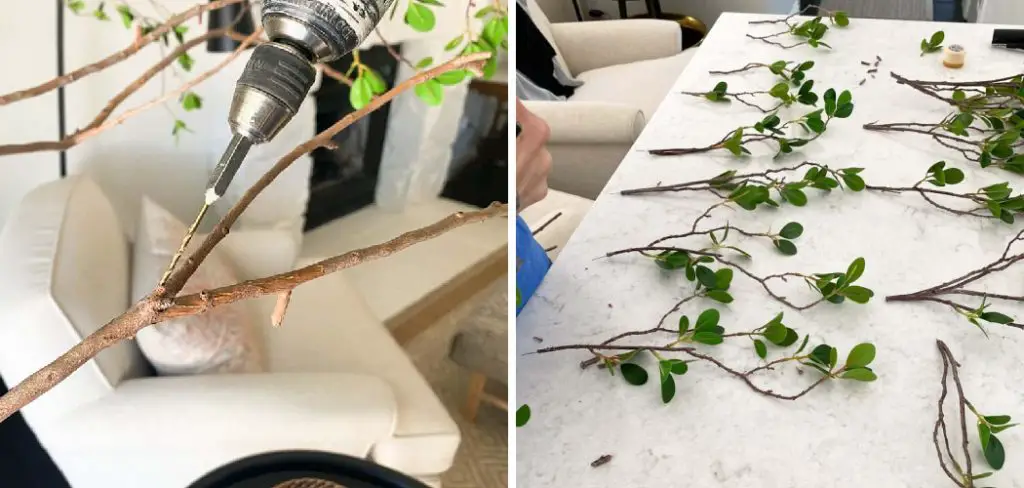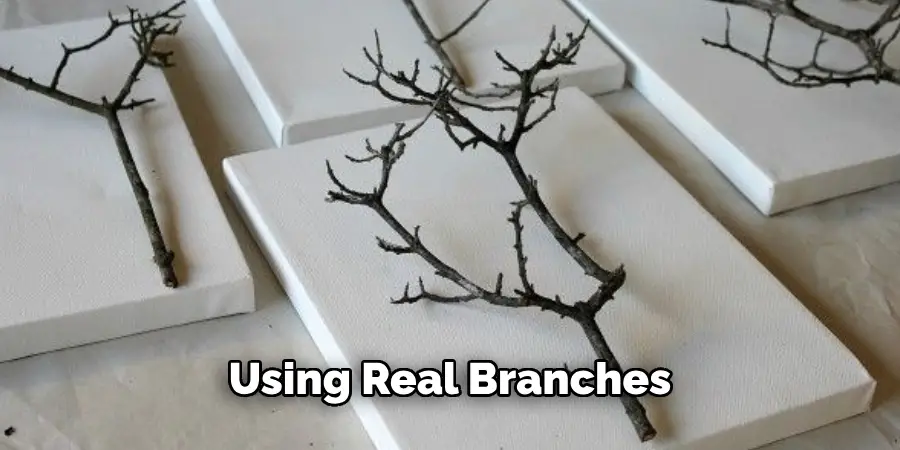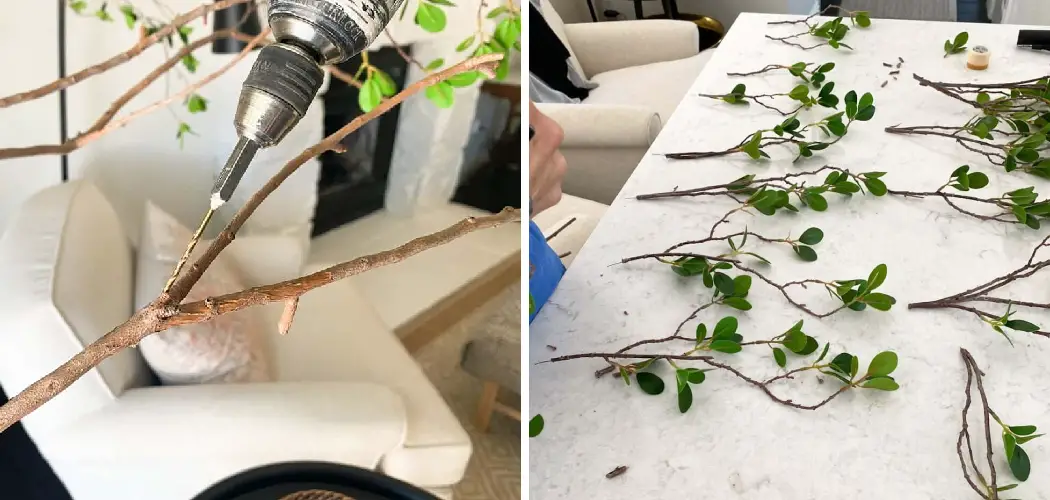Fake trees have become appealing for home decor, events, and displays due to their versatility and low maintenance. Whether creating a serene corner in a living room or adding a touch of nature to a wedding venue, these artificial trees offer endless possibilities.

One significant benefit of making your own fake tree is the ability to customize it according to your taste, ensuring it perfectly fits your aesthetic vision.
Moreover, crafting a fake tree can be a cost-effective alternative to purchasing a ready-made one, allowing for both creativity and savings. This article aims to provide a comprehensive step-by-step guide on how to make a fake tree with branches, helping you achieve a realistic and beautiful result that can be tailored to any setting.
Gathering Materials and Tools
To begin your project on how to make a fake tree with branches, gather the following materials and tools:
List of Materials:
- Real or artificial branches
- Sturdy base (e.g., a pot, wooden base, or stand)
- Foam or floral foam
- PVC pipe or wooden dowel for the trunk
- Hot glue gun and glue sticks
- Wire or floral tape
- Paint and brushes (optional)
- Moss, rocks, or decorative elements for the base
Preparing the Branches
Selecting Branches:
When selecting branches for your fake tree, choosing branches of various sizes is essential to achieve a natural look. Opt for a mix of thicker and thinner branches for the main structure to fill in the gaps and add detail. Whether you are using real or artificial branches, the size variation will help mimic the randomness found in actual trees, contributing to a more realistic appearance.
Cleaning and Trimming:

Cleaning the branches before attaching them to the trunk is crucial to removing any dirt and debris. This step is especially important for using real branches, as it ensures a neat and tidy final product. Once cleaned, trim the branches to your desired lengths and shapes using pruning shears or wire cutters. Trimming allows you to control the overall shape of your fake tree, making it easier to arrange the branches harmoniously.
Preserving Real Branches:
If you choose to use real branches, preserving them is important to keep them looking fresh and prevent decay. One method is to dry the branches thoroughly by leaving them in a dry, well-ventilated area for several weeks.
Alternatively, you can treat the branches with a sealant or clear spray paint to protect them from moisture and insects. Properly preserved branches will maintain their appearance and structural integrity, ensuring your fake tree remains beautiful and durable over time.
How to Make a Fake Tree with Branches Creating the Tree Trunk
Choosing the Trunk Material:
When deciding on the material for the trunk of your fake tree, two popular options are PVC pipe and wooden dowel. Each material has its own benefits and can be selected based on your desired height and sturdiness of the tree.
- Pvc Pipe: Lightweight and easy to cut, PVC pipes can be a great option if you want to create a tall tree without adding too much weight. They are also quite durable and can support multiple branches without bending.
- Wooden Dowel: A wooden dowel offers a more natural look and can provide a sturdy base for your fake tree. It is especially suitable for medium to smaller-sized trees. Wooden dowels can also be easily sanded, painted, or textured to enhance realism.
Attaching the Trunk to The Base:
Securing the trunk to the base is a critical step to ensure stability and upright positioning of your fake tree.

- Using Glue: Strong adhesives like epoxy or hot glue can be used to affix the trunk to a wooden base or pot. Make sure to apply the glue generously at the points of contact and hold the trunk steady until the glue sets.
- Using Screws or Nails: For additional stability, consider attaching the trunk using screws or nails. Drill a hole at the bottom of the PVC pipe or wooden dowel and insert a screw through the base into the trunk. This method provides a firm hold and ensures the trunk remains upright.
- Ensuring Stability: Regardless of the method used, check that the trunk is stable and level before proceeding. Adjustments may be required to achieve the desired upright position.
Adding Texture to The Trunk (optional):
To enhance the realism of your fake tree, you may add texture to the trunk.
- Using Bark: Applying pieces of real or artificial bark can give the trunk a lifelike appearance. Secure the bark using glue or nails.
- Using Twine: Wrapping twine around the trunk can create a rough, textured surface. Glue the ends to prevent unraveling.
- Using Paint: Painting the trunk with textured paint can mimic the look of tree bark. Consider using a base coat followed by dry brushing with lighter colors to highlight the texture.
Adding these elements will improve the visual appeal of your tree and make it a centerpiece of any room or event.
How to Make a Fake Tree with Branches Attaching Branches to the Trunk
Planning the Branch Layout:
Arranging the branches around the trunk before securing them is crucial for visualizing the final look of your fake tree. Lay out the branches in different positions to find the most natural and appealing arrangement. Ideally, the branches should be evenly distributed around the trunk, with some extending outward and others angled upward.

This will mimic the natural growth pattern of a real tree. Make sure to leave some gaps for additional smaller branches and foliage, which can be added later to enhance the tree’s fullness.
Securing Branches:
Once you’re satisfied with the branch layout, it’s time to start attaching them to the trunk. Hot glue, wire, or floral tape will ensure a secure and durable attachment.
- Hot Glue: Hot glue is perfect for securing smaller branches. Apply a generous amount to the base of the branch and press it firmly against the trunk. Hold the branch in place until the glue has set.
- Wire: For thicker branches, wire offers additional stability. Wrap the wire tightly around the base of the branch and the trunk. Floral tape can be used to hide the wire and create a more seamless look.
Attach branches at the trunk’s bottom and work your way up. This approach not only replicates the natural growth pattern of a tree but also makes it easier to balance the tree as you go. Test the stability of each branch before proceeding to the next one to ensure they are securely attached.
Reinforcing Connections:
After all the branches are attached, double-check that each one is securely fixed to the trunk. Give the tree a gentle shake to identify any loose connections. If a branch feels unstable, reinforce it with extra glue or wire.

- Adding Extra Glue: Apply additional hot glue to the base of any branch that needs more support. Hold it in place until the glue is thoroughly set.
- Using Extra Wire: For branches that still feel unstable, consider wrapping additional wire around the base and securing it tightly to the trunk.
Ensuring that all branches are securely attached and stable will prevent any mishaps and keep your fake tree looking beautiful over time. Reinforced connections will also allow you to adjust the branches’ positions slightly, providing flexibility in shaping the final appearance.
Adding Foliage and Decorations
Attaching Leaves:
Using artificial leaves or foliage adds realism to your fake tree. Begin by selecting high-quality artificial leaves that mimic the look and feel of real ones. These can be found in craft stores or online, and a variety of leaf types are available to suit the style of tree you’re creating.
- Using Glue: To attach the leaves, apply a small amount of hot glue to the base of each leaf, then press it firmly against the branch. Hold the leaf in place until the glue sets. This method is ideal for smaller, thinner branches where wire might be too conspicuous.
- Using Wire: Wire offers a secure option for thicker branches or when attaching clusters of leaves. Cut small pieces of floral wire and wrap them around both the base of the leaf and the branch. Twist the wire tightly to ensure it stays in place, then cover the wire with floral tape to hide the connection and create a seamless look.
Arrange the leaves in a natural pattern, ensuring they are evenly distributed along each branch. Vary the orientation and angle of the leaves to mimic the randomness found in nature. This will create a more lifelike and appealing look for your fake tree.
Adding Decorative Elements:
Incorporating decorative elements such as flowers, berries, or other items can enhance the overall appearance of your fake tree, making it a centerpiece for any room or event.
- Using Flowers and Berries: Select artificial flowers or berry sprigs that complement the color and style of your tree. Attach them using the same glue or wire methods as for the leaves. Place flowers or berries sparingly among the branches to avoid overwhelming the tree’s natural look.
- Ensuring Harmony: When adding decorations, ensure that they complement the tree’s overall appearance. Consider the color palette and theme, and avoid adding too many diverse elements that could clash. A few well-placed decorations can make a significant impact without detracting from the tree’s realism.

By carefully attaching leaves and adding tasteful decorative elements, you’ll create a visually stunning fake tree that remains beautiful and durable over time.
Final Touches and Base Decoration
Stabilizing the Tree:
Focus on reinforcing the base to ensure that your fake tree stands securely and remains stable over time. Begin by adding foam or floral foam to the trunk container. This material provides a sturdy foundation and helps keep the trunk in place. Cut the foam to fit snugly into the base, and then push the trunk into the foam until it feels secure.
Next, cover the foam to both improve stability and enhance the visual appeal. To achieve this, you can use materials like moss, rocks, or decorative pebbles. Not only do these elements add weight to prevent tipping, but they also create a more natural and finished look. Place a generous layer of moss or rocks around the base, covering all visible foam for a seamless appearance.
Painting and Finishing Touches:
For added realism, consider painting the branches or trunk. Choose colors that closely match natural tree bark, such as shades of brown and grey. Using a small brush, apply a layer of paint to any areas that need more texture or color. Dry brushing techniques can highlight the ridges and furrows of your tree, adding depth to the finish.
Additionally, touch up any visible glue or wire to ensure a polished final appearance. Use small amounts of paint or floral tape to conceal these areas. If you’ve used wire to attach larger branches, a light coat of matching paint will help blend these sections seamlessly with the rest of the tree.

By taking these final steps, you’ll anchor your fake tree securely and give it a refined, lifelike appearance. The added weight at the base will stabilize the tree, while the painting and finishing touches will enhance its overall aesthetic appeal.
Displaying and Maintaining Your Fake Tree
Placing the Tree:
Choosing a suitable location for your fake tree is crucial to ensure both its stability and visual impact. Place your tree in an area that offers ample space, avoiding high-traffic zones where it might get knocked over.
Consider the lighting conditions; placing the tree near natural light can enhance its realism but ensure that the tree is not in direct sunlight for extended periods to prevent fading. Once you’ve selected the perfect spot, check that the base is level and that the tree stands firmly without wobbling. If necessary, adjust the foam or add more stabilizing material to ensure it doesn’t tip over.
Maintenance Tips:

Regular maintenance is key to keeping your fake tree looking its best. Dust the leaves and branches periodically using a soft cloth or a gentle brush to remove dust and debris. For more thorough cleaning, use a damp cloth with mild soap and water, but take care to avoid soaking the materials.
Inspect your tree regularly for any loose branches or decorations, and reattach them using either glue or wire as previously described. Keeping an eye on and addressing these small maintenance tasks will ensure that your fake tree remains a stunning and durable addition to your decor for years to come.
Conclusion
In conclusion, learning how to make a fake tree with branches involves several creative and detailed steps. You can achieve a realistic look by selecting the right materials, shaping and painting the branches, and carefully attaching leaves.
Enhancing your tree with decorative elements like flowers or berries and stabilizing it with a solid base will ensure its durability and appeal. Painting and final touches add to the tree’s lifelike appearance. As you gain confidence, experiment with different materials and designs to personalize your creation.
DIY fake trees offer versatility, fitting seamlessly into home decor, event setups, or office environments. They provide a sustainable and low-maintenance alternative to real plants while retaining their aesthetic qualities. Crafting your own fake tree not only adds a unique touch to your space but also serves as a rewarding and creative endeavor.
About
Angela is the chief editor of Indoorense. She began her career as an interior designer before applying her strategic and creative passion to lifestyle and home.
She has close to 15 years of experience in creative writing and online content strategy for housekeeping and cleaning,home decorations as well as other efforts.
She loves her job and has the privilege of working with an extraordinary team. She lives with her husband, two sons, and daughter in Petersburg. When she’s not busy working she spent time with her family.

